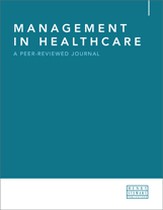Virtually integrated nursing care: A case study in diffusion of innovations
Abstract
Bedside nurses are suffering from nurse fatigue owing to excessive workload and work hours. Nurse fatigue results in missed nursing care, which has a direct impact on patient care and safety. Loss of experienced nurses also affects novice nurses, leaving them without strong mentoring. They may suffer from imposter syndrome, which instils self-doubt and limits their professional development, potentially resulting in burnout and attrition. A case study regarding the leadership of the Chief Nursing Officer as aligned with Rogers’ diffusion of innovations theory is presented. There is an initial accumulation of knowledge regarding the innovation, followed by persuasion (through perception of positive attributes to enhance speed of adoption), decision making, actual implementation and confirmation. Use of virtually integrated nursing helped alleviate bedside nurse fatigue by removing overtime hours and reducing workload. The virtually integrated nurses supported the bedside nurses, allowing them additional time in direct patient care, enhancing patient satisfaction and safety. The objective data indicates a decrease in patient fall by over 50 per cent. The integration of virtual nursing reversed the nurse attrition rates. Initial results revealed a 47 per cent reduction in registered nurse turnover. This allowed for retention of experienced nurses, which aids in mentoring novice nurses. The impact of virtually integrated nursing is yet to be completely realised. Based on this case study, the implementation of virtually integrated nursing is possible and beneficial to nursing, patient safety and the bottom line. This innovation had additional positive consequences and led to future considerations regarding continual process improvement and dissemination of knowledge.
The full article is available to subscribers to the journal.
Author's Biography
Kathleen Huun , PhD, holds a BS in nursing (Old Dominion University), BS in design and MS in textiles (University of California at Davis), MS in nursing education (Indiana State University) and a PhD in human sciences (Florida State University). She has an extensive background in critical care nursing and distance education. Dr Huun is an associate professor of nursing at Indiana State University. She was presented the Mildred Lemen Faculty Excellence Award in 2021 and the 2021 JCEN (Journal of Continuing Education in Nursing) Innovation award. Dr Huun’s research publications and presentations have focused on learning management system (LMS) template development; faculty availability/presence in online courses; development of the Licensed Practical Nurse (LPN) to Bachelor of Science in Nursing (BSN) Transition Journey Model; and, currently, the use of virtual simulation through e-simulation, video simulation, telepresence robot simulation, personal modular skills trainers and virtual reality simulation. She is currently working on a grant to provide virtually integrated care simulation to offer students an opportunity to learn this new technology and be better equipped to navigate through multifaceted, technology-based healthcare systems in their future practice.
Rachel Spalding , DNP, RN, NEA-BC, is sought out for her expertise in implementing virtually integrated care models. She earned a doctorate in nursing practice from Capella University, a master of science in nursing from the University of Southern Indiana, and a bachelor’s degree from Morehead State University. Dr Spalding is an advanced board-certified nurse executive and serves as a director at large on the Indiana State Nurses Association Board and is a board member for the Indiana Organization for Nursing Leadership. In her tenure as the Chief Nursing Officer at Good Samaritan from 2019 until May 2024, she successfully implemented a virtually integrated care model, received a 4th Magnet designation, and has been involved with the largest international clinician well-being study to date in her work with Dr Linda Aiken and the Magnet 4 Europe programme and received the ANCC award in October 2023. She presented in Washington, D.C. at the American Telemedicine Association Virtual Nursing Summit and received the ‘Best Case Study Award’ in November 2023. She also received a practice exemplar from the Magnet Commission on Virtual Nursing during her most recent designation. Currently, Dr Spalding is engaged in freelance consulting for virtual nursing, professional practice and workforce development.
Citation
Huun, Kathleen and Spalding, Rachel (2024, September 1). Virtually integrated nursing care: A case study in diffusion of innovations. In the Management in Healthcare: A Peer-Reviewed Journal, Volume 9, Issue 1. https://doi.org/10.69554/QJTL6989.Publications LLP
